what part of a transmitted frame changes from source to destination? what remains unchange?
New Version:
one. A network designer must provide a rationale to a customer for a design which will motion an enterprise from a apartment network topology to a hierarchical network topology. Which two features of the hierarchical design make it the amend choice? (Choose two.)
- lower bandwidth requirements
- reduced cost for equipment and user training
- easier to provide redundant links to ensure higher availability
- less required equipment to provide the same performance levels
- simpler deployment for additional switch equipment
two. What is a collapsed core in a network design?
- a combination of the functionality of the access and distribution layers
- a combination of the functionality of the distribution and core layers
- a combination of the functionality of the access and core layers
- a combination of the functionality of the access, distribution, and core layers
3. What is a definition of a 2-tier LAN network blueprint?
- access and core layers collapsed into 1 tier, and the distribution layer on a separate tier
- admission and distribution layers complanate into ane tier, and the core layer on a separate tier
- distribution and cadre layers collapsed into one tier, and the access layer on a split up tier
- admission, distribution, and cadre layers complanate into one tier, with a separate backbone layer
4. What is a bones part of the Cisco Borderless Architecture distribution layer?
- acting as a courage
- aggregating all the campus blocks
- aggregating Layer 3 routing boundaries
- providing access to end user devices
5. Which two previously contained technologies should a network administrator attempt to combine after choosing to upgrade to a converged network infrastructure? (Choose ii.)
- user data traffic
- VoIP phone traffic
- scanners and printers
- mobile cell phone traffic
- electrical organization
half-dozen. A local constabulary firm is redesigning the visitor network then that all 20 employees tin can exist connected to a LAN and to the Internet. The law house would prefer a depression toll and easy solution for the project. What type of switch should exist selected?
- fixed configuration
- modular configuration
- stackable configuration
- StackPower
- StackWise
7. What are two advantages of modular switches over fixed-configuration switches? (Choose two.)
- lower cost per switch
- increased scalability
- lower forwarding rates
- need for fewer power outlets
- availability of multiple ports for bandwidth aggregation
8. Which type of accost does a switch utilise to build the MAC address tabular array?
- destination IP accost
- source IP address
- destination MAC address
- source MAC address
ix. Which network device tin be used to eliminate collisions on an Ethernet network?
- firewall
- hub
- router
- switch
10. What two criteria are used by a Cisco LAN switch to make up one's mind how to frontwards Ethernet frames? (Choose ii.)
- path cost
- egress port
- ingress port
- destination IP address
- destination MAC address
xi. Refer to the exhibit. Consider that the main power has only been restored. PC3 issues a broadcast IPv4 DHCP request. To which port will SW1 forward this request?
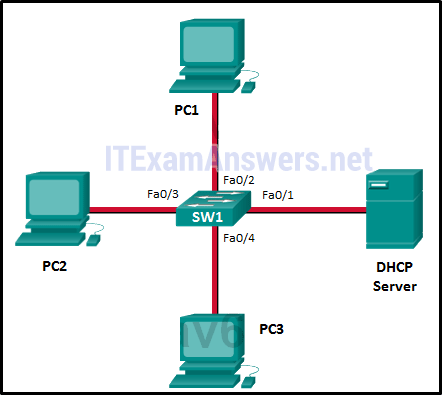
- to Fa0/1 only
- to Fa0/ane and Fa0/2 only
- to Fa0/1, Fa0/two, and Fa0/three simply
- to Fa0/1, Fa0/2, Fa0/3, and Fa0/4
- to Fa0/1, Fa0/2, and Fa0/iv only
12. What is one function of a Layer 2 switch?
- forwards data based on logical addressing
- duplicates the electrical signal of each frame to every port
- learns the port assigned to a host by examining the destination MAC address
- determines which interface is used to forward a frame based on the destination MAC accost
thirteen. Refer to the showroom. How is a frame sent from PCA forwarded to PCC if the MAC address table on switch SW1 is empty?
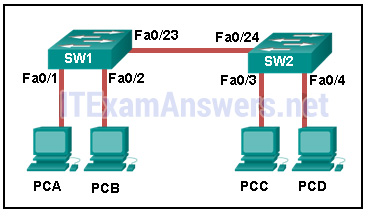
- SW1 floods the frame on all ports on the switch, excluding the interconnected port to switch SW2 and the port through which the frame entered the switch.
- SW1 floods the frame on all ports on SW1, excluding the port through which the frame entered the switch.
- SW1 forwards the frame straight to SW2. SW2 floods the frame to all ports connected to SW2, excluding the port through which the frame entered the switch.
- SW1 drops the frame considering it does not know the destination MAC address.
14. A small publishing company has a network design such that when a broadcast is sent on the LAN, 200 devices receive the transmitted broadcast. How can the network administrator reduce the number of devices that receive broadcast traffic?
- Add more switches so that fewer devices are on a detail switch.
- Replace the switches with switches that have more ports per switch. This will allow more devices on a particular switch.
- Segment the LAN into smaller LANs and route betwixt them.
- Replace at least half of the switches with hubs to reduce the size of the broadcast domain.
15. Refer to the exhibit. How many broadcast domains are displayed?
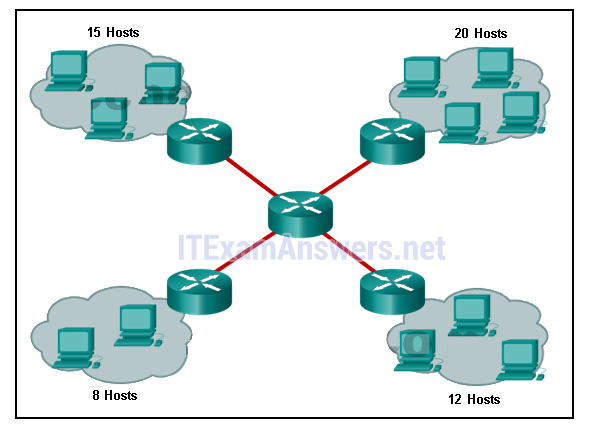
- 1
- 4
- viii
- sixteen
- 55
16. Which solution would aid a college alleviate network congestion due to collisions?
- a firewall that connects to two Internet providers
- a high port density switch
- a router with 2 Ethernet ports
- a router with 3 Ethernet ports
17. Which network device can serve as a boundary to separate a Layer 2 broadcast domain?
- router
- Ethernet bridge
- Ethernet hub
- admission point
18. What is the destination address in the header of a broadcast frame?
- 0.0.0.0
- 255.255.255.255
- 11-11-11-xi-11-eleven
- FF-FF-FF-FF-FF-FF
xix. Which statement describes a upshot after multiple Cisco LAN switches are interconnected?
- The circulate domain expands to all switches.
- Ane standoff domain exists per switch.
- Frame collisions increase on the segments connecting the switches.
- At that place is 1 broadcast domain and one standoff domain per switch.
20. What does the term "port density" represent for an Ethernet switch?
- the retentiveness infinite that is allocated to each switch port
- the number of available ports
- the numbers of hosts that are connected to each switch port
- the speed of each port
21. What are 2 reasons a network administrator would segment a network with a Layer 2 switch? (Cull two.)
- to create fewer standoff domains
- to raise user bandwidth
- to create more circulate domains
- to eliminate virtual circuits
- to isolate traffic between segments
- to isolate ARP request letters from the rest of the network
22. Fill in the bare.
A converged network is 1 that uses the aforementioned infrastructure to carry vocalization, data, and video signals.
23. Lucifer the borderless switched network guideline clarification to the principle. (Not all options are used.)
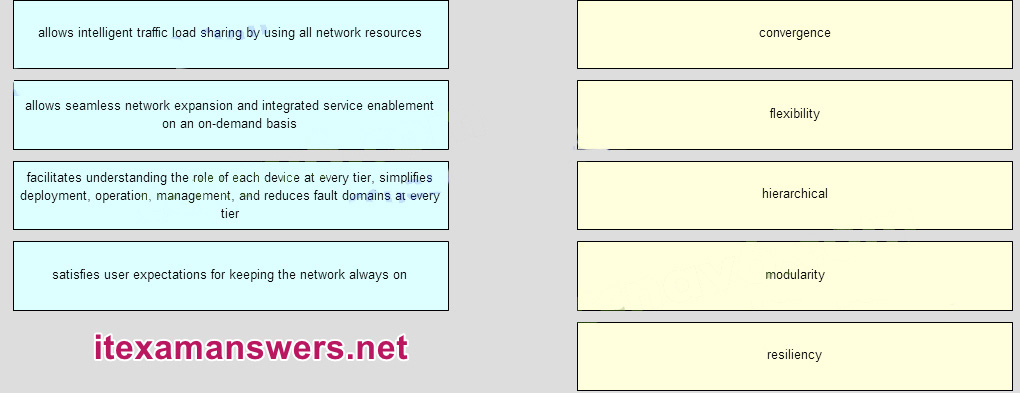
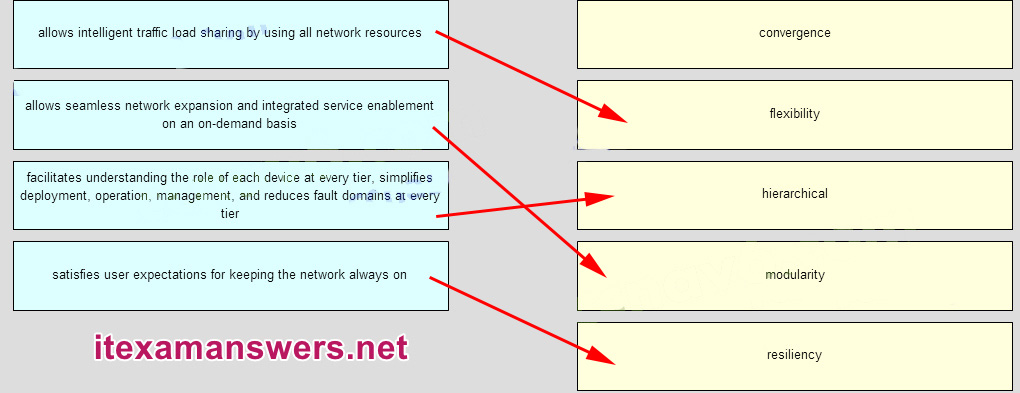
Place the options in the post-obit order:
allows intelligent traffic load sharing by using all network resources -> flexibility
facilitates understanding the role of each device at every tier, simplifies deployment, functioning, management, and reduces fault domains at every tier -> hierarchical
allows seamless network expansion and integrated service enablement on an on-demand basis -> modularity
satisfies user expectations for keeping the network always on -> resiliency
24. Match the functions to the corresponding layers. (Not all options are used.)
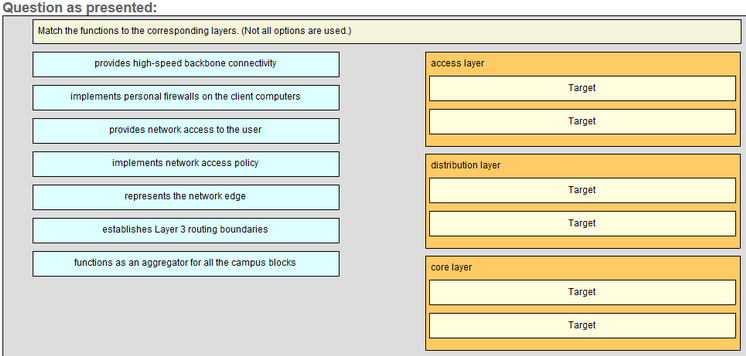

Place the options in the following order:
Access layer
[+] represents the network edge
[+] provides network access to the user
Distribution layer
[#] implements network access policy
[#] establishes Layer 3 routing boundaries
Cadre layer
[*] provides loftier-speed backbone connectivity
[*] functions as an aggregator for all the campus blocks
25. Match the forwarding characteristic to its blazon. (Not all options are used.)
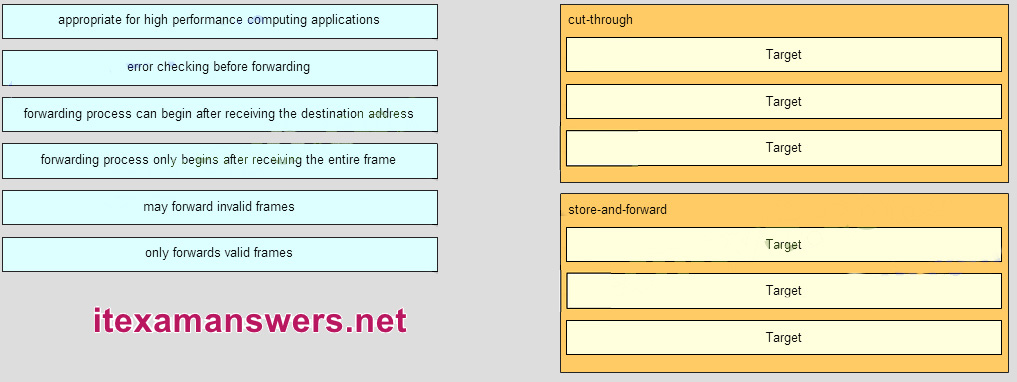
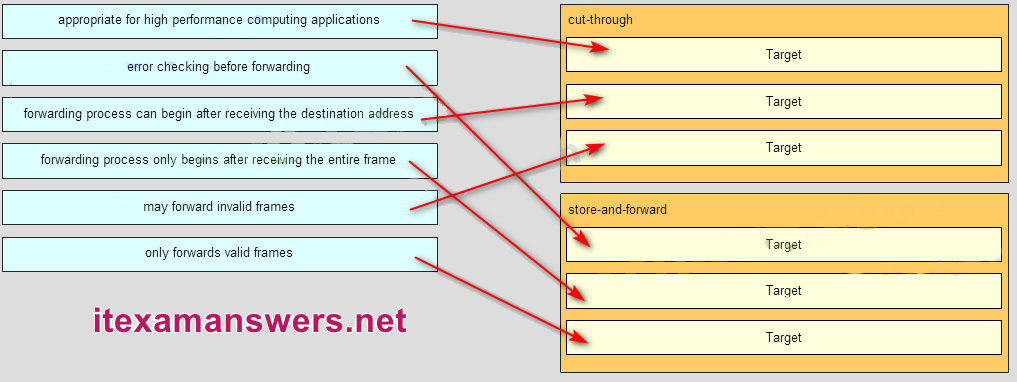
Place the options in the following order:
cut-throught:
+appropriate for loftier perfomance computing applications
+forwarding process tin can exist begin after receiving the destination accost
+may forwards invalid frames
store-and-forward:
#fault checking earlier forwarding
#forwarding process only begins after receiving the unabridged frame
#only forwards valid frames
Older Version:
26. What are two functions of a router? (Cull two.)
- It connects multiple IP networks.
- It controls the menses of data via the employ of Layer ii addresses.
- It determines the best path to send packets.
- It manages the VLAN database.
- Information technology increases the size of the broadcast domain.
27. Which ii statements correctly describe the concepts of authoritative altitude and metric? (Choose ii.)
- Authoritative distance refers to the trustworthiness of a detail road.
- A router first installs routes with higher administrative distances.
- The value of the administrative distance can not exist altered past the network administrator.
- Routes with the smallest metric to a destination point the all-time path.
- The metric is always determined based on hop count.
- The metric varies depending which Layer 3 protocol is being routed, such as IP.
28. In order for packets to exist sent to a remote destination, what 3 pieces of information must exist configured on a host? (Choose three.)
- hostname
- IP accost
- subnet mask
- default gateway
- DNS server address
- DHCP server accost
29. Which software is used for a network ambassador to make the initial router configuration securely?
- SSH client software
- Telnet client software
- HTTPS client software
- terminal emulation client software
thirty. Refer to the showroom. PC A sends a asking to Server B. What IPv4 address is used in the destination field in the packet as the packet leaves PC A?
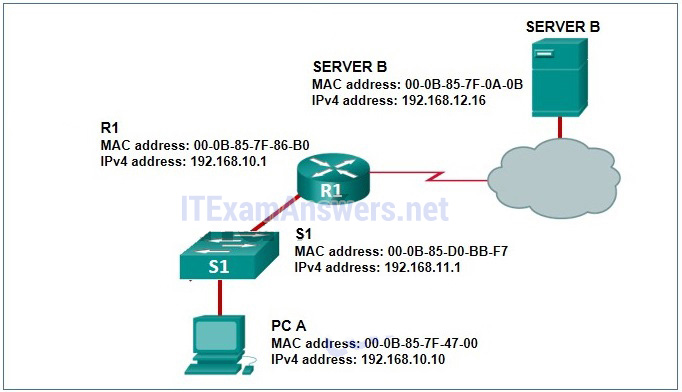
- 192.168.10.10
- 192.168.11.1
- 192.168.ten.1
- 192.168.12.16
31. Refer to the exhibit. A network administrator has configured R1 as shown. When the administrator checks the status of the serial interface, the interface is shown every bit being administratively down. What additional command must be entered on the serial interface of R1 to bring the interface up?

- IPv6 enable
- clockrate 128000
- stop
- no shutdown
32. What is a characteristic of an IPv4 loopback interface on a Cisco IOS router?
- The no shutdown control is required to place this interface in an UP state.
- It is a logical interface internal to the router.
- But one loopback interface tin can be enabled on a router.
- It is assigned to a physical port and tin can be connected to other devices.
33. What two pieces of information are displayed in the output of the show ip interface brief command? (Choose two.)
- IP addresses
- MAC addresses
- Layer one statuses
- side by side-hop addresses
- interface descriptions
- speed and duplex settings
34. What type of network uses one mutual infrastructure to deport vocalisation, data, and video signals?
- borderless
- converged
- managed
- switched
35. A packet moves from a host on 1 network to a device on a remote network within the aforementioned company. If NAT is not performed on the packet, which ii items remain unchanged during the transfer of the package from source to destination? (Choose two.)
- destination IP address
- source ARP table
- source IP address
- source MAC address
- destination MAC address
- Layer 2 header
36. Which ii items are used by a host device when performing an ANDing performance to determine if a destination address is on the aforementioned local network? (Choose two.)
- destination IP address
- destination MAC address
- source MAC accost
- subnet mask
- network number
37. Refer to the showroom. If PC1 is sending a packet to PC2 and routing has been configured betwixt the 2 routers, what will R1 practice with the Ethernet frame header attached by PC1?
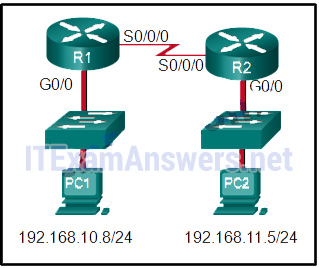
- nothing, because the router has a road to the destination network
- remove the Ethernet header and configure a new Layer 2 header earlier sending it out S0/0/0
- open the header and replace the destination MAC address with a new one
- open the header and use it to determine whether the information is to be sent out S0/0/0
38. Refer to the exhibit. What does R1 apply equally the MAC accost of the destination when constructing the frame that will go from R1 to Server B?
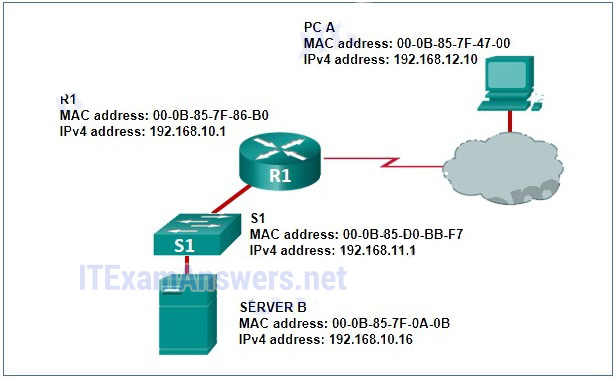
- If the destination MAC address that corresponds to the IPv4 address is not in the ARP cache, R1 sends an ARP request.
- The packet is encapsulated into a PPP frame, and R1 adds the PPP destination address to the frame.
- R1 uses the destination MAC accost of S1.
- R1 leaves the field blank and frontwards the data to the PC.
39. Refer to the exhibit. What will the router do with a bundle that has a destination IP accost of 192.168.12.227?
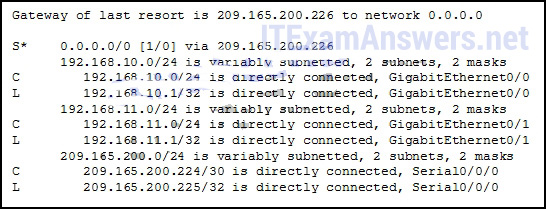
- Drop the packet.
- Send the packet out the Serial0/0/0 interface.
- Send the bundle out the GigabitEthernet0/0 interface.
- Send the packet out the GigabitEthernet0/1 interface.
xl. Which two parameters are used by EIGRP as metrics to select the best path to accomplish a network? (Cull two.)
- hop count
- bandwidth
- jitter
- resiliency
- filibuster
- confidentiality
41. What route would take the everyman administrative distance?
- a direct connected network
- a static road
- a road received through the EIGRP routing protocol
- a route received through the OSPF routing protocol
42. Consider the following routing tabular array entry for R1:
D ten.1.1.0/24 [90/2170112] via 209.165.200.226, 00:00:05, Serial0/0/0
What is the significance of the Serial0/0/0?
- It is the interface on R1 used to send data that is destined for 10.1.one.0/24.
- It is the R1 interface through which the EIGRP update was learned.
- Information technology is the interface on the terminal destination router that is directly connected to the 10.1.one.0/24 network.
- Information technology is the interface on the next-hop router when the destination IP address is on the x.1.ane.0/24 network.
43. What are ii common types of static routes in routing tables? (Choose two)
- a default static route
- a built-in static road by IOS
- a static route to a specific network
- a static road shared between 2 neighboring routers
- a static route converted from a route that is learned through a dynamic routing protocol
44. What command volition enable a router to brainstorm sending messages that allow information technology to configure a link-local address without using an IPv6 DHCP server?
- the ipv6 route ::/0 command
- a static route
- the ip routing command
- the ipv6 unicast-routing command
45. What is one feature that distinguishes routers from Layer 2 switches?
- Routers can be configured with IP addresses. Switches cannot.
- Switches move packets from 1 physical interface to another. Routers do not.
- Switches employ tables of information to determine how to process data traffic. Routers do non.
- Routers support a diverseness of interface types. Switches typically back up Ethernet interfaces.
46. What type of IPv6 address is required as a minimum on IPv6 enabled interfaces?
- loopback
- unique local
- link-local
- static
- global unicast
47. When a computer is pinging another figurer for the starting time time, what type of bulletin does information technology place on the network to determine the MAC address of the other device?
- an ICMP ping
- an ARP request
- an RFI (Asking for Information) bulletin
- a multicast to any Layer iii devices that are connected to the local network
48. What address changes equally a packet travels beyond multiple Layer 3 Ethernet hops to its final destination?
- source IP
- destination IP
- source Layer 2 accost
- destination port
49. Refer to the exhibit. A network ambassador issues the show ipv6 route control on R1. What two conclusions can be fatigued from the routing tabular array? (Choose two.)
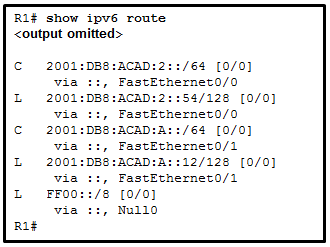
- static route
- local host route
- straight connected network
- road that is learned through the OSPF routing protocol
- route that is learned through the EIGRP routing protocol
50. Refer to the exhibit. A network administrator issues the testify ip road command on R2. What two types of routes are installed in the routing tabular array? (Choose two.)
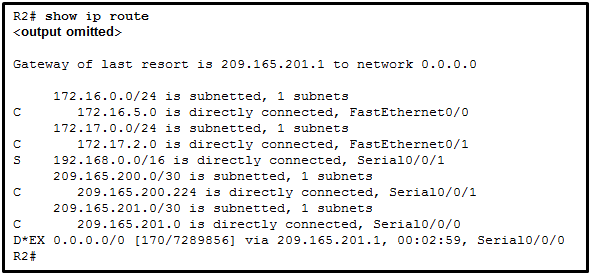
- a configured default road
- directly connected networks
- routes that are learned through the OSPF routing protocol
- routes that are learned through the EIGRP routing protocol
- a configured static route to the network 209.165.200.224
51. What blazon of IPv6 accost is required equally a minimum on IPv6 enabled interfaces?
- static
- global unicast
- link-local
- loopback
- unique local
52. Lucifer the forwarding characteristic to its blazon. (Not all options are used.)

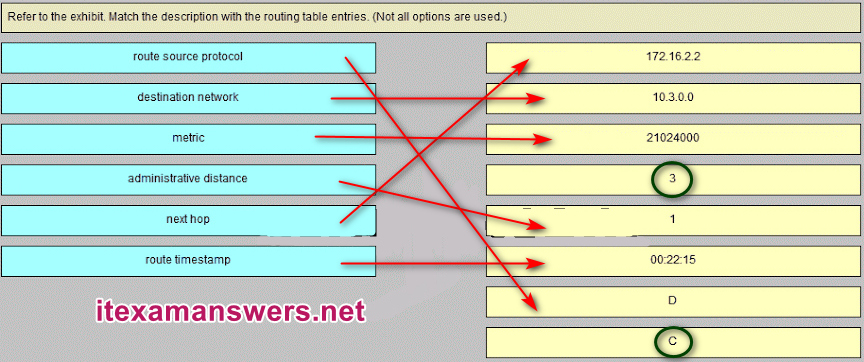
172.xvi.ii.2 -> next hop
10.3.0.0 -> destination network
21024000 -> metric
1 -> administrative altitude
00:22:15 -> route timestamp
D -> road source protocol
53. Refer to the exhibit. A network administrator bug the testify ipv6 road control on R1. What two conclusions tin can exist drawn from the routing tabular array? (Choose ii.)

- Packets that are destined for the network 2001:DB8:ACAD:2::/64 will exist forwarded through Fa0/i.
- R1 does not know a route to any remote networks.
- The interface Fa0/1 is configured with IPv6 address 2001:DB8:ACAD:A::12.
- Packets that are destined for the network 2001:DB8:ACAD:2::54/128 will be forwarded through Fa0/0.
- The network FF00::/8 is installed through a static route control.
54. Refer to the exhibit. What is the purpose of the highlighted field in the line that is displayed from the show ip road control?

- Information technology indicates that this is a straight continued road.
- Information technology indicates that this route has been deleted from the routing table.
- Information technology indicates that this route was learned via EIGRP.
- It indicates that this is a default route.
55. Refer to the showroom. PC1 attempts to connect to File_server1 and sends an ARP request to obtain a destination MAC accost. Which MAC address volition PC1 receive in the ARP reply?
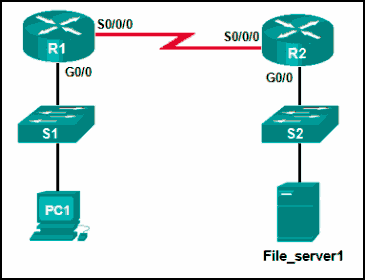
- the MAC address of File_server1
- the MAC address of S2
- the MAC address of the G0/0 interface on R2
- the MAC address of S1
- the MAC address of the G0/0 interface on R1
56. A network administrator configures the interface fa0/0 on the router R1 with the control ip accost 172.sixteen.1.254 255.255.255.0. However, when the ambassador issues the command testify ip route, the routing table does not show the directly connected network. What is the possible cause of the trouble?
- The interface fa0/0 has non been activated.
- No packets with a destination network of 172.16.ane.0 have been sent to R1.
- The subnet mask is wrong for the IPv4 address.
- The configuration needs to be saved start.
57. Which control is used to configure an IPv6 accost on a router interface then that the router will combine a manually specified network prefix with an automatically generated interface identifier?
- ipv6 enable
- ipv6 address ipv6-address/prefix-length eui-64
- ipv6 address ipv6-address/prefix-length link-local
- ipv6 address ipv6-address/prefix-length
58. Fill in the bare.
When a router receives a packet, it examines the destination accost of the packet and looks in the " routing " table to determine the all-time path to use to forward the package.
59. A network administrator configures a router by the control ip route 0.0.0.0 0.0.0.0 209.165.200.226. What is the purpose of this command?
- to provide a route to forward packets for which there is no route in the routing tabular array
- to forrard packets destined for the network 0.0.0.0 to the device with IP address 209.165.200.226
- to add a dynamic route for the destination network 0.0.0.0 to the routing tabular array
- to forward all packets to the device with IP address 209.165.200.226
60. Refer to the showroom. A network ambassador issues the evidence ipv6 road command on R1. Which two types of routes are displayed in the routing table? (Choose ii.)

- route that is learned through the EIGRP routing protocol
- directly connected network
- route that is learned through the OSPF routing protocol
- static road
- local host route
61. A network administrator is implementing dynamic routing protocols for a company. Which command can the administrator issue on a router to display the supported routing protocols?
- Router(config)# router ?
- Router(config)# ip frontward-protocol ?
- Router(config)# service ?
- Router(config)# ip route ?
62. Which statement describes a route that has been learned dynamically?
- It is identified by the prefix C in the routing table.
- It is automatically updated and maintained by routing protocols.
- It is unaffected past changes in the topology of the network.
- It has an administrative distance of one.
63. Which two network parameters are used by EIGRP equally metrics to select the best path to attain a network? (Cull Two.)
- jitter
- bandwidth
- resiliency
- hop count
- filibuster
- confidentiality
64. What are 2 types of static routes in routing tables? (choose two)
- default static route
- built in static route by IOS
- static road to specific network
- static road converted from a route that is learned through a dynamic routing protocol.
- static route shared btween two neighboring routers.
65. What is a characteristic of an IPv4 interface on a Cisco IOS router?
- it is assigned to a physical port and tin can be connected to other devices.
- only one loopback int can be enable on a router
- it is a logical int internal to the router
- the no shut command is required to place this in Upwardly
Download PDF File below:
[sociallocker id="54558″]
[/sociallocker]
freemanforneved1945.blogspot.com
Source: https://itexamanswers.net/ccna-2-v5-0-3-v6-0-chapter-4-exam-answers-100-full.html
ارسال یک نظر for "what part of a transmitted frame changes from source to destination? what remains unchange?"